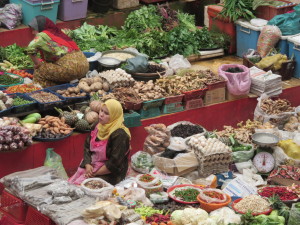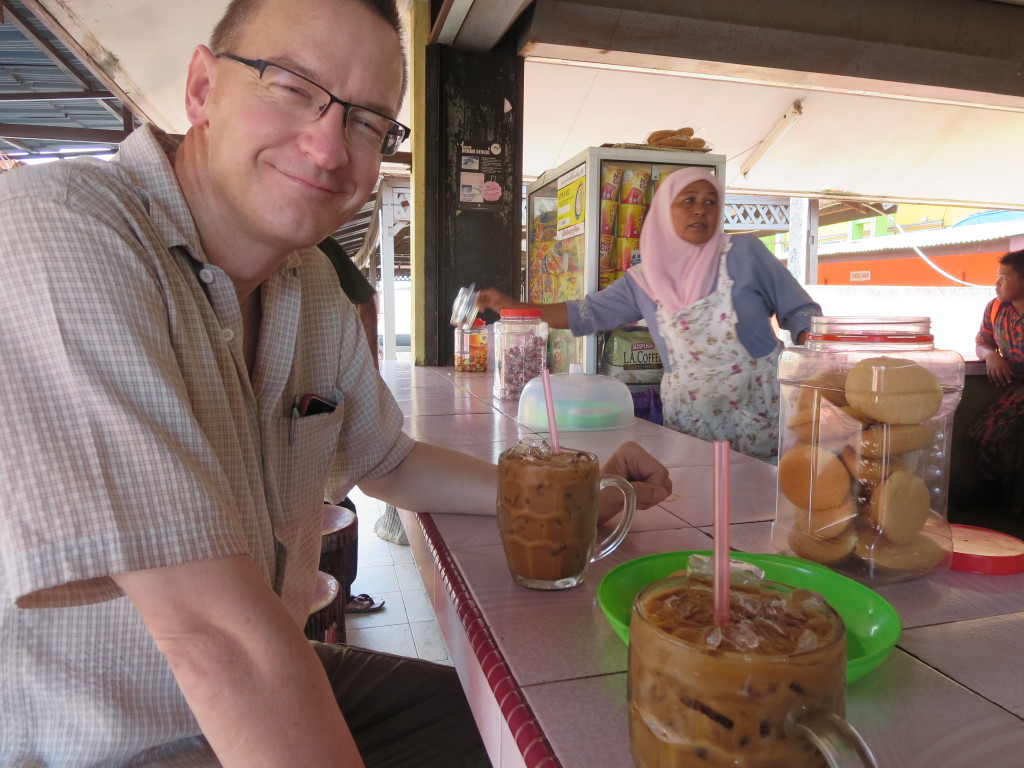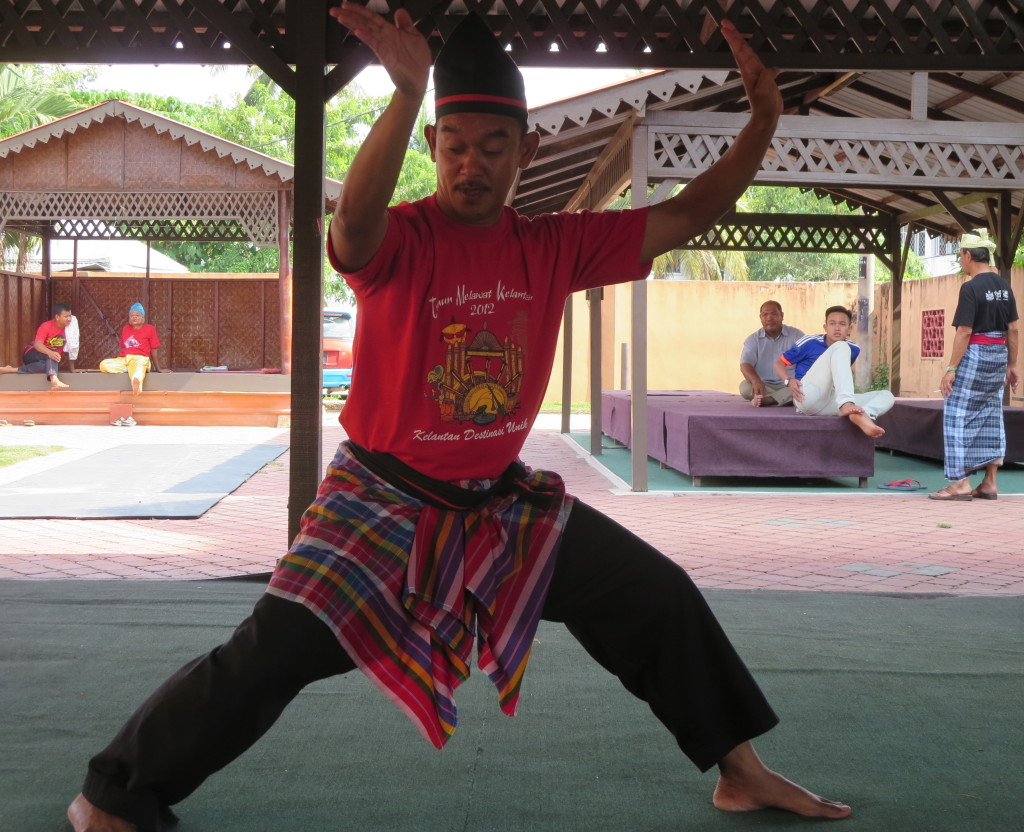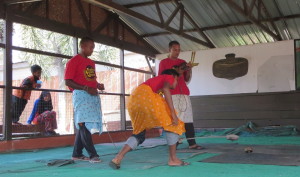
Conserving Noisy Culture In Kelantan
Kota Bharu, the capital of Malaysia’s Kelantan province, is a quiet city.
There seem to be wider, more plentiful streets than the people need. Few people tread the sidewalks. We don’t see lunch crowds. Or dinner crowds.
When, on our first night in town, we see a vocal group performing at Hawker’s Square, we think, “Great! We’ll catch a few minutes of this and take in all of tomorrow night’s performance when we’re better rested.” The next night there is no performance, and darn little commerce. In Kelantan, it seems, night markets do not share daily rhythm with their Thai counterparts.

A thin but excited crowd cheers on a local music and comedy act. The circle of people behind the two men with mics are a mixed hand and drum rhythm section. In retrospect, we think the troupe got permission to perform in public because they are nominally Islamic. Click the picture to enlarge and read the sign in the foreground.
Kota Bharu has a ring-shaped central market. The center open area for fresh produce is about the size of two basketball courts. There are four floors of dry goods with large, arched, glass-free windows looking into the central courtyard. It is, bar none, the quietest agricultural market we’ve visited. There’s more empty boxes than produce, the sellers sit almost silently behind their wares, and the buyers are sparce.

Two sellers and no buyers is the watchword in this part of the Kota Bharu central market. Click the photo to enlarge.
Is this Malay culture? Is this a somber period of mourning we don’t know about? Is this the winter of the Kelantanian soul?
It is with some trepidation, then, that we head to the Kelantan Cultural Center. Our trepidation is multiplied when we enter the courtyard: a dozen children, aged about ten, are working quietly on a craft project; a man with a booth is working at batik, patiently applying small dots of wax to cloth in preparation for dyeing; five women are shifting back and forth between the craft project and a small food stall, where a half-dozen men laze on stools and chat almost without gesture.
A thin, older Malayian man with a heavy accent and nearly perfect command of English idiom–we later learn he is the master of ceremonies–welcomes us, let’s us know we are thirty minutes early, ushers us into the shade of the food stall, and suggests we have an ice coffee while we wait.

Your reporter at the Culture Center food counter, enjoying his iced coffee and spongy baked treats in the plastic jar. I think the treats are called kuhi bhaulu and came to Malaysia through Chinese cooks. Click the photo to enlarge.
Our optimism is raised: the coffee meets traditional standards by being milky and sweeter than any Starbucks-style dessert drink. We try a snack of whipped egg white, rice flour, and sugar, poured into a mold and baked. Think meringue cookie crossed with the cake from a Twinkie: golden, sponge-like, simple, fresh, delicious.
More Malay arrive. One, with a jagged array of front teeth, enters the courtyard with a big smile and a flute. He puts the flute to his lips and announces his entrance with a beautiful flourish of notes and then a laugh. Our optimism rises again. Later we will wonder what his best instrument is…he plays masterful percussion the rest of the day.
A handful of other tourists arrive, some European, some American, a couple from Brazil. There are no buses of school kids, no tours making use of this free resource. Later we learn the Cultural Center is part of an uneasy truce between the arch-conserviative State government and those trying to keep non-islamic aspects of Kelantanian arts alive.

Alison take a turn in the drum rectangle. The wooden slot drums are tricked out, but in many spots the yellow paint is cracking away. Click the photo to enlarge
Our first taste of noisy Kelantan culture is a drum rectangle. Six men wearing tanjak, colorful folded head scarves, play slotted wooden drums using thick mallets, one end of which is coated with natural rubber. Of the performers, only one looks over thirty–a good sign: younger people have learned the traditional instruments and songs–and his white hair and mile-wide grin make you think that picked up his first stick when he was three, whacked a coconut husk, was immediately in love, and has been tattooing everything with drumsticks ever since.
The Malaysian martial art, silat (or, more properly silat Melayu), is also a noisy, boisterous affair. At least as performed at weddings. What?! Malaysians perform martial arts at weddings? Yes, the ‘art’ part of Malaysian martial arts involves juicing up the movement component (Dare I say “dance?”) and giving performances at important social events, including weddings. At our Kota Bharu demonstration, a six-piece band traditional band made a wall of sound for one, then two martial artists. Fluttering fingers play a significant role in increasing the esthetic value, as do the musicians. The tunes sounded like they had a lot of improvisational elements, and that must invite the martial artists into improvisational territory.

The beginning of a silat Melayu performance. Note the wide separation of the feet and the cocked thumbs. Were this a motion picture, you would see a fluttering the little fingers relative to the rest. For all the world it looks like a bird’s wings fluttering. What we saw was graceful and concentrated, not speedy. Click the photo to enlarge.
When two ‘fighters’ were going at it, the movement turned even more graceful, with interplay where energy was accumulated and moved back and forth between the practitioners. Part of the ‘game’ was acknowledging when the other ‘dancer’ had penetrated a defense. The display was fascinating, with wide, near-the-ground footwork, a clear sensitivity for the four drums, one cymbal, and one snake-charmer’s oboe in the band, and a kind of fluidity that made the sum of the parts entertaining for those who don’t have a life-long interest in martial arts.

Traditional top-spinning action! One top is in play on the bottom right side of the frame. A bigger top is unreeling, while the man in the white sarong is winding up his top. Click the photo to enlarge.
A whole different kind of noise is being preserved in traditional Kelantan top spinning. Hear the whirr as solid teak tops the size of a softball are sent spinning with a long coil of rope. Hear the bullwhip-like crack! as the tip of the rope breaks the sound barrier. Hear the thunk! as one top smacks into another, trying knock competitors’ tops out of the playing field. Hear the nervous laughter as the knocked top, missile-like, barely misses the head of a seated player.
After darkness falls, the Cultural Center pulls out its big guns: shadow puppets.
You might think shadow puppetry to be a sedate undertaking, but not in Malaysia. A traditional orchestra, heavy with drums, clashing cymbals, and screaming double reeds sits behind the screen with the puppet master, setting the mood and punctuating the action. The puppet master is a master vocalist as well: he has a unique voice for each character and can project that voice out into the audience even when the band is blaring along at full volume.
In truth, we came to this corner of Malaysia because I wanted to see wayang kulit, these shadow puppets. They are the Shakespeare of southeast Asia, telling stories from the Indian classics like the Ramayana, and like Shakespeare, there is low comedy mixed in with high drama.

A buffalo-hide wayang kulit puppet in the bright light of day. Beautiful before the action and beautiful in action. Click the photo to enlarge.
I’d never seen the puppets until we got to Malaysia, and while I knew they were made of buffalo hide, I did not know the hide was translucent and that the puppets were painted with translucent colors, giving them far greater visual affect than I expected.
And the puppets have a great range of animation: some have intricately designed jaws to make their dialogue appear startlingly real. And the puppet master can have them saunter in one scene, take to their heels another, or inch forward with interest while a comrade speaks.

And unexpected meeting, mismatched size, and smart remarks add up to low comedy. In this scene from the Ramayana, the demon on the left interrogates a human. The human puppet has a specially articulated head so it can better shake with comic fear. Click the photo to enlarge.
Yes, the audience multiplies for the night’s performance. Kids show up at the 9 PM start and stay glued to the action until 11:30 PM. Perhaps more surprising is that the bulk of the audience is middle-aged Malaysian men: it appears this form of entertainment was much more common forty years ago and they return to enjoy the pleasures of their youth.
I, too, enjoy the pleasures of their youth,
Chris
Recent Comments